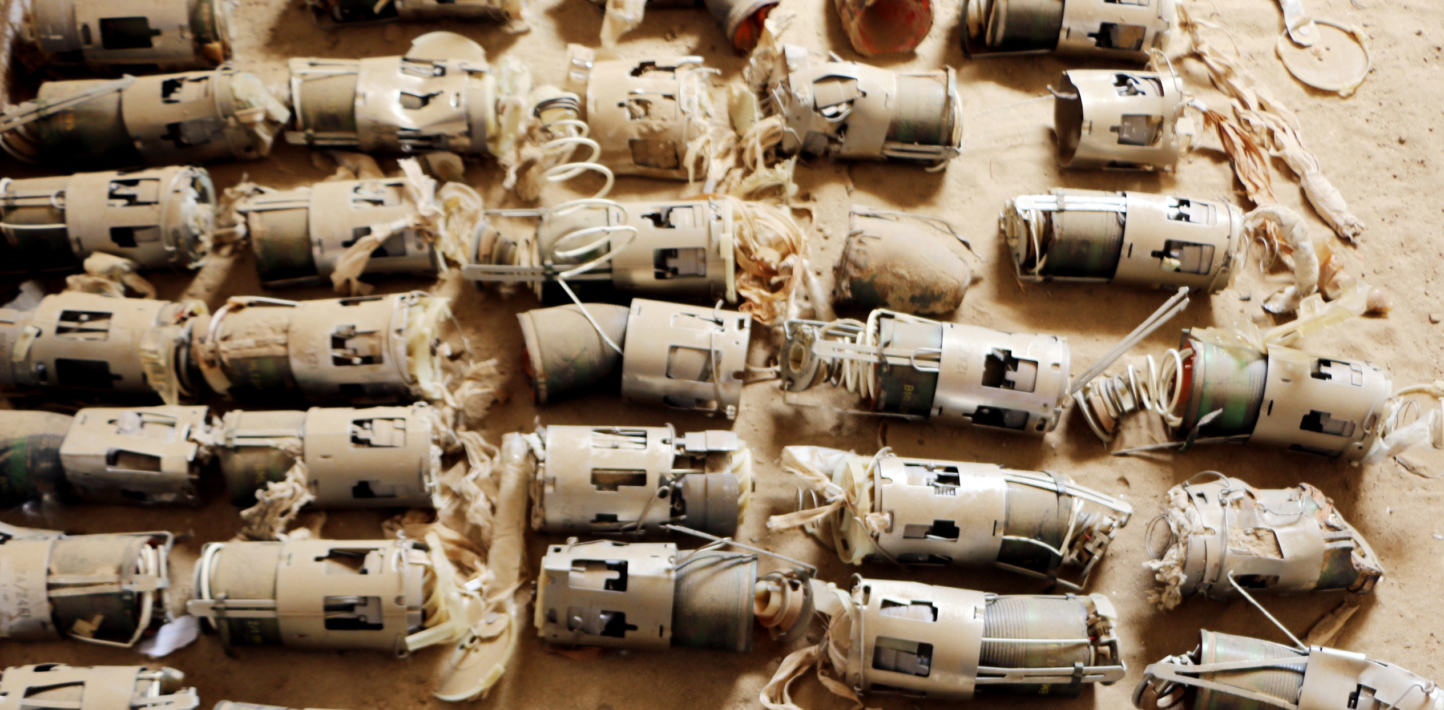- 16 new civilian casualties, including nine children, documented in aftermath of Saudi Arabia-led coalition’s cluster bomb use
- Internally displaced people returning home to de facto ‘minefields’
- Use of US, UK and Brazilian-made cluster munitions documented
- Urgent need for international demining assistance
Children and their families returning home in northern Yemen after a year of conflict are at grave risk of serious injury and death from thousands of unexploded cluster bomb submunitions, Amnesty International said, following a 10-day research trip to Sa’da, Hajjah, and Sana’a governorates.
International assistance is urgently needed to clear contaminated areas and countries with influence should urge the Saudi Arabia-led coalition forces to stop using cluster munitions, which are internationally banned and inherently indiscriminate.
“Even after hostilities have died down, the lives and livelihoods of civilians, including young children, continue to be on the line in Yemen as they return to de facto minefields. They cannot live in safety until contaminated areas in and around their homes and fields are identified and cleared of deadly cluster bomb submunitions and other unexploded ordnance,” said Lama Fakih, Senior Crisis Advisor at Amnesty International.
Even after hostilities have died down, the lives and livelihoods of civilians, including young children, continue to be on the line in Yemen as they return to de facto minefields.
Lama Fakih, Senior Crisis Advisor at Amnesty International
On its most recent mission to northern Yemen, Amnesty International found evidence of US, UK and Brazilian cluster munitions used by the Saudi Arabia-led coalition forces. The use of cluster bombs is banned under the Convention on Cluster Munitions, to which the UK is a State Party.
The organization interviewed 30 people, including survivors of cluster bomb submunitions and other unexploded ordnance (UXO) as well as their families, eyewitnesses, demining experts, activists and first responders.
It documented 10 new cases in which 16 civilians were injured or killed by cluster munitions between July 2015 and April 2016. This includes nine children, two of whom were killed. These casualties took place days, weeks, and sometimes months after the bombs were dropped by coalition forces in Yemen.
With a lull in fighting along the Yemeni-Saudi border since a local ceasefire was agreed in March 2016, civilians began returning home and felt safer moving around the governorates of Hajjah and Sa’da. But demining officials, local residents and first responders told Amnesty International they continued to see civilians injured by explosions, with a rise in casualties from unexploded ordnance particularly in areas along the Saudi Arabia-Yemen border including in Midi, Haradh, Hayran, Bakil al-Mir, and Mustabah in Hajjah governorate and al-Safra, Razih, Shada and Baqim in Sa’da governorate.
Many civilians, including children, are now exposed to potentially deadly submunitions and other explosive remnants of war without any knowledge of their presence or the risk they pose. Meanwhile, recent flood waters have moved the submunitions and other unexploded ordnance into areas where civilians do not expect them to be.
Up to this point, the Saudi Arabia-led coalition has not formally confirmed its use of cluster munitions. However, in an interview with CNN on 11 January 2016, the spokesperson of the coalition’s military forces, General Ahmed al-Asiri, categorically denied that the coalition had used cluster munitions in attacks anywhere in Yemen other than in one instance, describing the use of air-dropped CBU-105 Sensor Fuzed Weapons on a military target in Hajjah in April 2015.
Civilians describe dire need of assistance to clear contaminated areas
Recognizing the serious risk unexploded ordnance presents to the civilian population, Yemen’s sole demining agency, the Yemen Executive Mine Action Centre (YEMAC), began clearing and detonating the weapons in Sa’da and Hajjah in early April 2016, despite being ill-equipped and trained.
While the full extent of cluster munition contamination is not yet known, in the first three weeks of their work, YEMAC records show its teams working in Sa’da and Hajjah governorates cleared at least 418 cluster bomb submunitions, 810 fuses and artillery remnants, 51 mortars and more than 70 missiles.
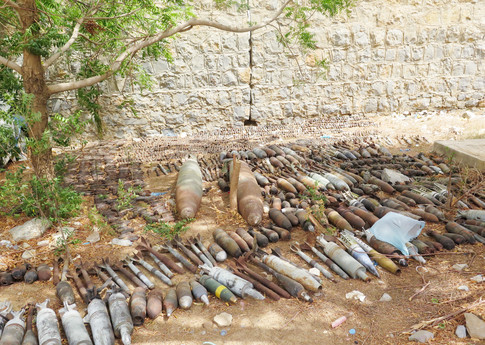
Tragically, the centre had to abruptly halt its clearing operations on 26 April after three of its staff members, Mohammed Ahmed Ali Al Sharafi, Mustafa Abdullah Saleh Al Harazi, and Hussein Abdo Mohssien Al Salami, were killed in a cluster munition incident while carrying out their work in Hayran in Hajjah governorate.
The Director of YEMAC, Ahmed Yahya Alawi, told Amnesty International that the centre’s clearance work was suspended pending an investigation into the men’s deaths, but that he believed the deaths were caused by one of the men’s failure to take adequate precautions in moving the submunitions and his proximity to his colleagues when doing so. He blamed the men’s inadequate training and lamented the ineffectiveness and age of their equipment.
“[Different] types of cluster munitions have been used [by the coalition] but we have only worked with four of the types before. We were surprised by the new kind. They are more sensitive… It is difficult to get explosives to detonate the bombs but storing them is dangerous” he said. “We need to bring in trainers from the countries that made the weapons to train the employees…[and] we are looking for better technology to destroy these bombs.”
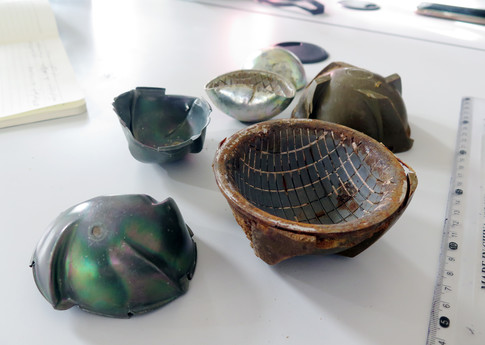
“Donor countries must act quickly to support local efforts to safely and urgently locate, mark and clear areas contaminated by unexploded ordnance and educate affected communities on how to avoid danger in the meantime,” said Lama Fakih.
Failure to safely clear submunitions and other explosive remnants of war will be a ticking time bomb for civilians, including children, living in affected areas.
Lama Fakih
“Failure to do so will be a ticking time bomb for civilians, including children, living in affected areas.”
Children are particularly at risk of picking up and playing with submunitions, which they mistake for toys, given their small size and shape. Some roughly resemble drink cans, while others resemble balls.
Amnesty International interviewed a 13-year-old boy who was injured in the late afternoon on a day in January 2016 after apparently picking up a submunition near a spring that locals rely on for water in Noug’a, a small village surrounded by agricultural land in al-Safra, Sa’da governorate, approximately 20-25 kilometres from the border with Saudi Arabia. According to locals interviewed by Amnesty International, the area is separated from the frontlines by a few kilometres and during the heavy fighting, they hear the sound of incoming and outgoing ground-launched attacks.
The victim said the bomblets were green and shaped like “a small ball that you play with.” This description is consistent with the US-made BLU-63 cluster bomb submunitions.
The boy said the bomblets were green and shaped like “a small ball that you play with.”
13-year-old cluster bomb victim in Noug’a, al-Safra, Sa’da governorate
“I saw the bomb [submunition] close to where we were filling water and as I was walking along I saw it [on the ground]. I picked it up and I threw it [to the side] and it exploded. I got hurt and then my brother went to get help…” He was hospitalized for two months and had an operation on his abdomen. He told Amnesty International that there are still submunitions next to the spring.
On 1 March, “Walid” (children’s names have been changed for their security) another 11-year-old from a nearby area, was also hurt by a submunition, losing three of his fingers and breaking his jaw. His brother, “Samih,” an eight year old, was killed.
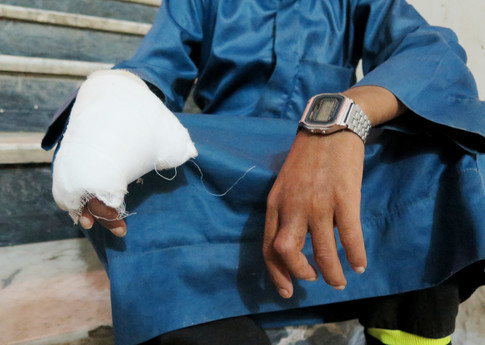
Walid told Amnesty International that he and Samih were near the village of Fard, al-Safra directorate in Sa’da, on 1 March when they encountered multiple submunitions while herding goats in a valley. He said that he and Samih were carrying around and playing with submunitions for several hours when one eventually exploded around 1pm, killing Samih instantly and injuring Walid. Amnesty International observed that Walid lost three fingers on his right hand and that he had had an operation to insert steel plates in his left jaw, which was broken in the blast. He also sustained shrapnel injuries to his chest and legs.
I started to take the red string with my right hand and pull and [Samih] pulled on the other end of it and then it went off and I fell back. [Samih] was hurt in his stomach and he had fallen down too. We didn’t know it would hurt us.
Walid, an 11-year-old boy from Fard, al-Safra directorate in Sa’da
“We go down every day to the valley to herd goats, where there are many small bombs. We found four of them in the morning… they were cylindrical with a red ribbon. We carried them with us while herding. At around 1pm, I started to take the red string with my right hand and pull and [Samih] pulled on the other end of it and then it went off and I fell back. [Samih] was hurt in his stomach and he had fallen down too. We didn’t know it would hurt us.”
Based on the description, these appear to be ground-launched “ZP 39” DPICM submunitions, which have been documented by Human Rights Watch in northern Yemen in May 2015.
On 16 April in a village in Hajjah governorate around 10 kilometres from the Saudi Arabian border, a 12-year-old boy was also killed and his nine-year-old brother injured when they played with cluster bomb submunitions while they herded goats in the valley nearby. According to family members, fighting fronts are a few kilometres closer to the border and local residents told Amnesty International that fighters were sometimes forced to retreat into nearby villages to seek shelter from Saudi fire.
The nine-year-old boy who survived told Amnesty International:
“I found the bomb and I went and gave it to my brother so he can have one and I had one. He hit them against each other and they exploded and I found myself lying on the ground. The explosion pushed me back [several metres]. Two or three days before the accident, my friend and I used to go and collect the bombs and put them in a bag and hide them under and between the trees. They have a white ribbon.”
His 12-year-old brother was killed on the spot, with his abdomen torn open and his arm severed.
The boys’ father, who has 13 other children, told Amnesty International that the family had only recently returned to the area, after being displaced by airstrikes. He said they do not go back to the valley after the incident, but there are no safe spaces to herd their goats: “In the area next to us, there are bombs hanging off the trees,” he said.
In the area next to us, there are bombs hanging off the trees.
Goat herder and father of 13 from Hajjah governorate
Other goat herders told Amnesty International the prevalence of cluster bomb submunitions in grazing areas has forced them to keep their goats locked up and feed them straw, which is costly and not sustainable. In most cases farmers and herders told Amnesty International they had no choice but to work in contaminated areas despite the risks.
“The significant number of submunitions used by the Saudi Arabia-led coalition forces and the high dud rates have not only killed and maimed, but also severely damaged livelihoods by killing livestock and turning agricultural land into de facto minefields, interfering with animal herding as well as harvesting of banana, mango and tomato crops,” said Lama Fakih.
In many instances, civilians returning home told Amnesty International that they have had to resort to removing submunitions themselves, fearing that children will pick them up or their livestock will be injured.
Hindi Ibrahim, a 25-year-old father of two from Dugheij Village, Hayran, Hajjah governorate, told Amnesty International how his arm was injured by an explosion when he and other villagers attempted to clear hundreds of cluster bomb submunitions from their village:
“The original strike happened late July/last August during the day and [some of] the bomblets exploded. There were also Apaches [helicopters] that shot at people as they ran away. There were 500 pieces in the village everywhere … we wanted to remove them. Some were inside the house in the courtyard and kitchen…[YEMAC] kept on promising they would come but they never came. They told us they were busy in other areas. By February, we were forced to clean them ourselves because of the [risk to] children. At the time I went into the house and put 10 [submunitions] on a tray and carried them out of the house. The bombs started hitting against each other and one went off. I dropped the tray and the rest went off.”
Hindi Ibrahim sustained shrapnel injuries in his right elbow, right abdomen and right hip.
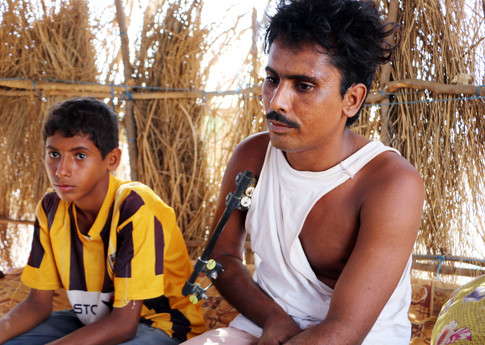
Amnesty International also interviewed his brother, Weedi Ibrahim, 30, and his nephew, Yahya Shawqi, 15, who were both also injured when they handled submunitions in the village. According to Hindi Ibrahim, two other villagers were killed in recent months when they picked up submunitions and they went off.
First confirmed use of UK-made cluster munitions in Yemen
Since the start of the Saudi Arabia-led air campaign on 25 March 2015, Amnesty International has documented the use of six types of cluster munitions in Yemen (see full table below) by the coalition forces. Other credible sources including Human Rights Watch have also documented their use.
Amnesty International’s most recent mission confirmed, for the first time, that coalition forces have used UK-manufactured BL-755 cluster munitions in Yemen. The BL-755 was manufactured by Hunting Engineering Ltd in the 1970s. This variant, designed to be dropped from the UK Tornado fighter jet, contains 147 submunitions designed to penetrate 250mm of armour while at the same time breaking into more than 2,000 fragments which act as an anti-personnel weapon. The weapon is known to be in the stockpiles of both Saudi Arabia and the United Arab Emirates.
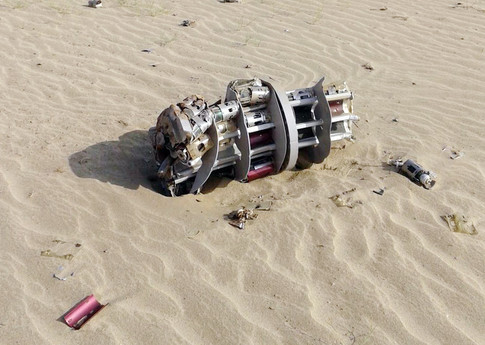
Amnesty International’s research team located the BL-755 bomb in Hayran in the centre YEMAC was using to store unexploded ordnance they had collected. The bomb had malfunctioned and bomblets in five of the original seven sections had neither dispersed nor detonated as designed. Around a dozen bomblets were still inside in the crushed remains of the bomb casing and YEMAC had stored another 70 or so bomblets in the same facility indicating that 80 or so bomblets, more than half, failed to detonate.
This is the first confirmed use of UK-made cluster munitions since the adoption in 2008 of the Convention on Cluster Munitions, which the UK played a role in drafting and negotiating.
Other types recently identified by Amnesty International include a Brazilian-manufactured Avibras ASTROS cluster munition rocket motor and US-manufactured CBU-105 Sensor-Fuzed Weapons with BLU-108/B canisters. A US Department of Defense contract worth $641 million for the manufacture of 1,300 CBU-105 sensor fused weapons for Saudi Arabia was agreed in August 2013. The weapon is also known to be in the stockpile of the United Arab Emirates.
The BLU-108, manufactured by Textron Defense Systems, is an air-delivered submunition, with four further smart “Skeet” submunitions. The BLU-108 is released from the bomb that carries it, and a parachute deploys to slow its descent. It then fires the four rapidly-rotating skeets, which using multi-mode optical sensors can identify a variety of targets. When the skeet identifies a target signature it detonates, propelling an explosively formed penetrator to penetrate armour and produce incendiary effects, as well as a fragmentation ring to damage soft targets and personnel.
The presence of dud skeet submunitions in Yemen which have failed to deploy, detonate or self-destruct contradicts claims by the US Security Defense Cooperation Agency that these munitions do not result in more than 1% unexploded ordnance “across the range of intended operational environments.” The US government prohibits the sale or transfer of cluster munitions with greater than a 1% fail rate. The US appears to be failing to meet even this standard, which falls short of the complete ban on the use, production, transfer and stockpiling of cluster munitions that the 100 states parties to the Convention on Cluster Munitions have committed to.
Recommendations
“Without a concerted effort to stop the Saudi Arabia-led Coalition from using cluster munitions, and urgent international support for clearance, these cluster bombs and other explosive remnants of war will leave a deadly legacy in Yemen for years to come, posing a threat to civilian lives and wreaking havoc on the local economy,” said Lama Fakih.
[Unless action is taken,] these cluster bombs and other explosive remnants of war will leave a deadly legacy in Yemen for years to come, posing a threat to civilian lives and wreaking havoc on the local economy.
Lama Fakih
Saudi Arabia and other coalition members should facilitate clearance of areas contaminated by unexploded ordnance. States in a position to do so should provide all possible technical, financial, material, and other assistance to facilitate the marking and clearance, removal or destruction of cluster bomb submunitions, duds and other explosive remnants of war. They should also provide victim assistance, including for the medical and psychological care and rehabilitation of victims and their families, as well as risk education.
Members of the Saudi Arabia-led coalition should immediately provide the UN with precise locations of cluster munition attacks, including maps, data with the exact dates of strikes, specific types and quantities of the weapons used, in order to facilitate clearance and risk-education activities and to reduce the potential for further civilian casualties.
States supplying arms to the Saudi Arabia-led coalition and the coalition members should immediately stop transferring and using cluster munitions, and should decommission and dispose of their remaining stocks without further delay.
Background
Amnesty International and others have been calling on all states for years to immediately halt the use, production, transfer and stockpiling of cluster munitions and to join the 2008 Convention on Cluster Munitions (CCM).
The other countries who have produced cluster munitions identified as being used by the Saudi Arabia-led coalition in the Yemen conflict – the USA and Brazil – have not yet joined the CCM. Neither has Yemen – although Yemeni diplomats indicated on 19 May at a UN conference that they were strongly considering acceding to the Convention, given the level of cluster munition contamination in the country.
Neither Saudi Arabia nor any of its coalition members have joined the CCM. However, under customary international humanitarian law, coalition members must not use inherently indiscriminate weapons, which invariably pose a threat to civilians.
Since February 2016, Amnesty International has urged all states to ensure that no party to the conflict in Yemen is supplied – either directly or indirectly – with weapons, munitions, military equipment or technology that would be used in the conflict until they stop serious violations of international human rights and humanitarian law and support independent, impartial investigations into allegations of violations by all parties.


